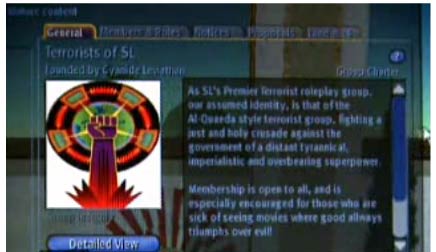… if your life isn’t fulfilling enough, you can join Second Life — where anything goes. David Pogue and Kristen Powers take you into the bowels of the web: SecondLife.
The awesome virtual world of Second Life seems to be exploding into a new life for many millions of internet users. But any world where you can do what you want without facing consequences could lead to problems — particularly for young, learners.
Parents should take note. Educators everywhere are debating the pros and cons of Second Life as a teaching aid. Many warn there is a real ‘underworld’ with seedy, shadowy things that shouldn’t be made available to everyone.
In late February, David Pogue took a virtual stroll through Second Life for CBS news. Unfortunately the video is poorly made, and not on a good streaming server, so it may be jerky. But check it out, David — as always — does a wonderful job of enlightening us to Second Life…
If you are able to read between the lines, you’ll guess there are frightening and dangerously compulsive things awaiting teenagers and children in the virtual world.
Pogue says:
> You’re represented by a computer-generated character
> (an avatar) that can walk around, fly, teleport, or
> exchange typed comments with other people’s characters.
> You can make yourself young and beautiful, equip yourself
> with fancy clothes …
> The average member spends four hours a day in Second Life.
The web in itself is compulsive. But it looks like this new world takes compulsive to new extremes. Unlike virtual worlds up until now, Second Life takes money.
David continues…
> One thing that makes Second Life different from other online
> 3-D games is its economy. People make stuff and sell it
> to each other … Second Life itself is free, but members
> nonetheless pay real money — $220 million a year — to buy
> these imaginary accessories.
This is not a bad thing in itself. It takes video realism to a new level — you’re actually interacting with real people. What worries me is the aspect of organized crime setting up industry there. Unlike the real world, you have no sense of those you come in contact with beyond what they present. The perfect masquerade so to speak. And that means a gold mine for criminals and a free and wide-open shopping ground for predators of all kinds.
Pogue handles it all in his usual happy-go-lucky, diplomatic way. Kirsten Powers, Fox News Political Analyst and former Deputy Assistant U.S. Trade Representative for the Clinton administration, reports on it somewhat differently.
Seedy World of Second Life
In her online article “The Seedy World of Second Life”, Kirsten Powers shows some of the more undesirable aspects of Second Life . You’ll visit Sen. John Edwards’ installation of the first ever virtual presidential campaign headquarters. Don’t look now, but it’s in a neighborhood with rape fantasy clubs and child sex brothels. Many campaigners as well as big corporate giants are indeed anxious to set up shop in SecondLife. Why not — the seedy life is the biggest draw on the web, and likely to bring the most pairs of eyes — revenue and campaign funds.

Watch Powers’ video report is ‘must see’ … www.powers-point.com
One of the most interesting things Powers points out is the the child sex brothel called Jailbait. Here, your avatar can watch or participate in pedophilia activities — although the owners of “Jail Bait” call it “age-play.”
In The Second Life Herald by philosophy professor Peter Ludlow, you can read a rather revealing interview with Emily Semaphore, the 35 year-old librarian, who manages Jailbait in the avatar of a 13 year old girl. Her Second Life club features cybersex between participants — who may be children.
Emily boasts:
> Some people only play in a nonsexual manner,
> others only play sexually, many mix both.
> There are teens and tweens and yeah diaper kids.
You can read this and other articles at www.secondlifeherald.com, which the author clearly states has no ties whatsoever with the web entity called SecondLife.
Boring for intelligent people?
David Pogue relates:
> The first time I tried Second Life, I must admit
> I was a little bewildered. I was a little bored,
> because I couldn’t find anyplace to go to find
> people.
Kirsten Powers discovered the same thing. Everywhere she went the streets and landscapes were empty. She had trouble finding anyone to talk to. Even Edwards’ campaign headquarters was never manned. She was able to join a terrorist organization though.

But the spokesman for Second Life says:
> For any digital world to be reasonably interesting,
> it always has to be hackable in some sense …
> people are always going to be able to come up with
> a sort of a virus, or a way of making each other
> angry, if the environment is open enough for it
> to be interesting. And Second Life is a great
> example of that.
> … in just a few years, this is gonna look
> like walking into a movie screen.
> And that’s just gonna be such an amazing thing.
The question is: what kind of movie?
Educators are now wrestling with many questions surrounding the SecondLife. Some advocate that it’s a wonderful learning experience for young people — others wager caution that it will eventually be a haven of stalkers and criminals. The overwhelming question is what kind of “experience” do we wish to teach, and what kind of citizens do we want taking our places in society?
What kind of life is SecondLife?
Anything the user wants to make of it.
* Watch David Pogue’s CBS video news story
Special thank to my brother, Joe Showker for leading the way on this article. He sends along some other links for serious scrutiny:
* Future and virtual rapists
*
Wired: Second Life Teaches Life Lessons
*
Thanks for reading…
Fred Showker, Editor, Graphic Design & Publishing